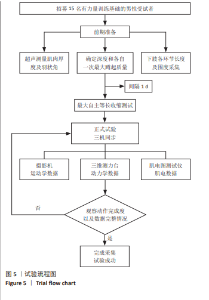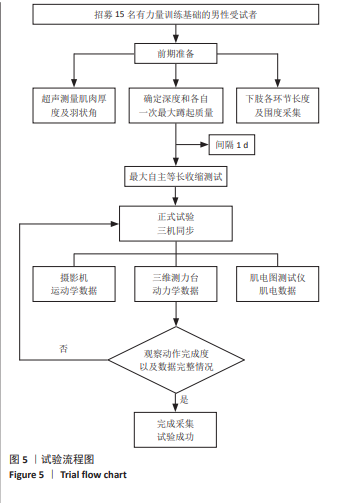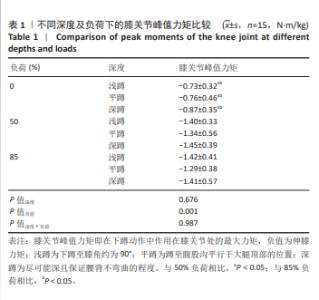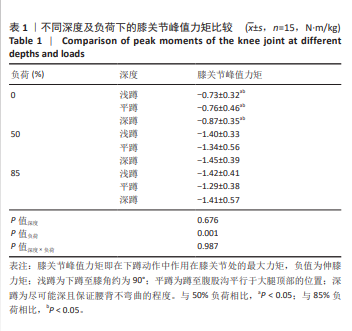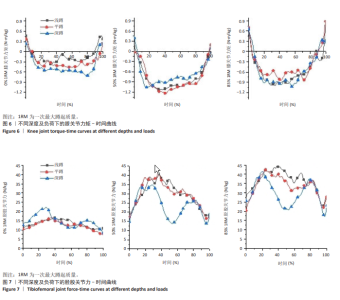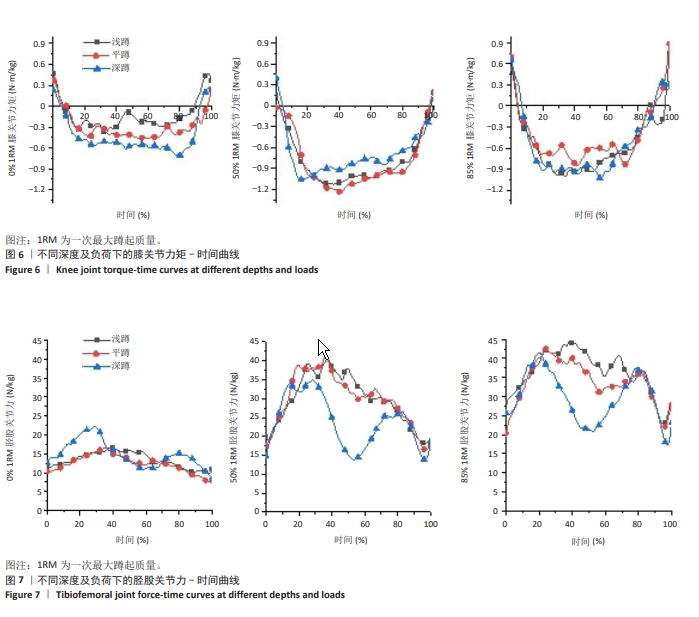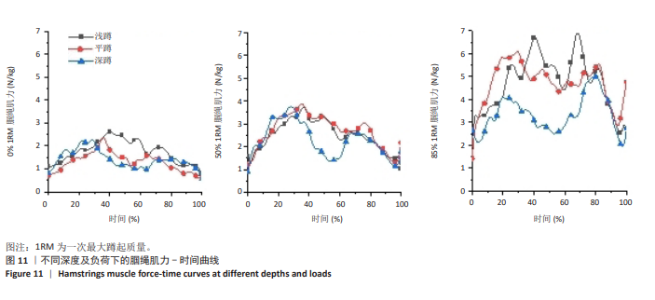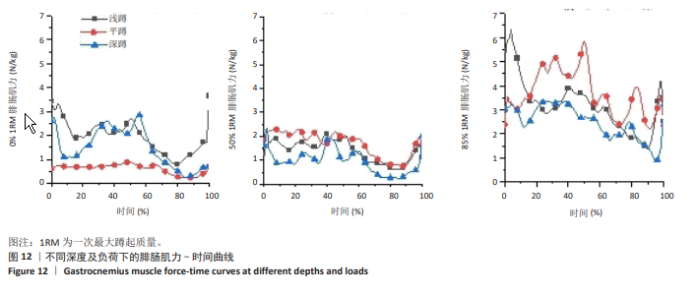Chinese Journal of Tissue Engineering Research ›› 2026, Vol. 30 ›› Issue (9): 2236-2247.doi: 10.12307/2025.829
Previous Articles Next Articles
Influence of different depths and loads on knee joint mechanics and peripheral muscle force characteristics during squatting
Yan Xiangning1, Chen Lei2, Chen Yonghuan3, Wang Chao4, Li Xiaosheng5
- 1College of Physical Education, Shaanxi College of Communications Technology, Xi’an 710018, Shaanxi Province, China; 2Qindu Vocational Education Center, Xianyang 712000, Shaanxi Province, China; 3Pukyong National University, Busan 48513, South Korea; 4School of Physical Education, Xinyu University, Xinyu 338000, Jiangxi Province, China; 5School of Sports and Health Science, Xi’an Physical Education University, Xi’an 710068, Shaanxi Province, China
-
Received:2024-05-29Accepted:2024-08-05Online:2026-03-28Published:2025-09-05 -
Contact:Chen Yonghuan, Doctoral candidate, Pukyong National University, Busan 48513, South Korea Li Xiaosheng, MS, Associate professor, School of Sports and Health Science, Xi’an Physical Education University, Xi’an 710068, Shaanxi Province, China -
About author:Xianyang 712000, Shaanxi Province, China; 3Pukyong National University, Busan 48513, South Korea; 4School of Physical Education, Xinyu University, Xinyu 338000, Jiangxi Province, China; 5School of Sports and Health Science, Xi’an Physical Education University, Xi’an 710068, Shaanxi Province, China Yan Xiangning, MS, Teaching assistant, College of Physical Education, Shaanxi College of Communications Technology, Xi’an 710018, Shaanxi Province, China -
Supported by:Scientific Research Project of Shaanxi Provincial Sports Bureau in 2022, No. ST20224205 (to LXS)
CLC Number:
Cite this article
Yan Xiangning, Chen Lei, Chen Yonghuan, Wang Chao, Li Xiaosheng. Influence of different depths and loads on knee joint mechanics and peripheral muscle force characteristics during squatting[J]. Chinese Journal of Tissue Engineering Research, 2026, 30(9): 2236-2247.
share this article
Add to citation manager EndNote|Reference Manager|ProCite|BibTeX|RefWorks
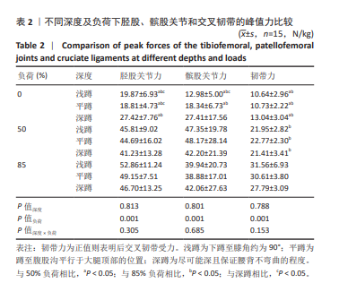
2.4 不同深度及负荷下胫股、髌股关节和交叉韧带受力 对于胫股关节力,负荷对胫股关节力具有主效应(F=45.543,P=0.001);组间对比结果显示,与85%和50%负荷相比,0%负荷的胫股关节力显著降低(P < 0.05);组内对比结果显示,处于0%负荷时,与深蹲相比,浅蹲和平蹲的胫股压力均显著降低(P < 0.05),见表2。 对于髌股关节力,负荷对髌股关节力具有主效应(F=11.864,P=0.001);组间对比结果显示,与85%和50%负荷相比,浅蹲和平蹲下的0%负荷显著降低(P < 0.05);组内对比结果显示,处于0%负荷时,与深蹲相比,浅蹲有着较小的髌股关节力(P < 0.05),见表2。 对于交叉韧带力,对交叉韧带力具有主效应(F=155.627,P=0.001);组间对比结果显示,与85%和50%负荷相比,0%负荷的韧带力显著降低(P < 0.05),与85%负荷相比,50%负荷有着较小的韧带力(P < 0.05);组间对比结果显示,三者的两两比较差异无显著性意义(P > 0.05),见表2。"

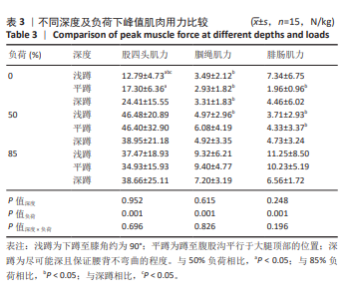
如图7所示,浅蹲和平蹲的变化趋势较为一致。随着下蹲深度的增加,胫股关节力出现了双峰特征,且胫股关节力峰值多出现在动作初期;如图8所示,髌股关节力先随着动作的进行先上升,后到达峰值后缓慢下降,髌股关节力也出现了随着深度的增加而出现双峰趋势,即在接近下蹲的底部时,髌股关节力下降后上升;如图9所示,在下蹲动作中交叉韧带力值一直为正,代表后交叉韧带持续受力。随着下蹲深度的增加,后交叉韧带力也呈双峰趋势。 2.5 不同深度及负荷下肌肉用力情况 对于股四头肌力,负荷对股四头肌力具有主效应(F=10.939,P=0.001);组间对比结果显示,浅蹲和平蹲下的0%负荷与50%负荷相比,股四头肌力显著减小(P < 0.05);组内对比结果显示,处于0%负荷时,与深蹲相比,浅蹲有着较小的股四头肌力(P < 0.05),见表3。 "
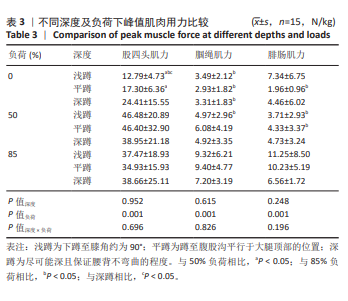

对于腘绳肌力,负荷对腘绳肌具有主效应(F=13.310,P=0.001);组间对比结果显示,与85%负荷相比,0%负荷有着较小的腘绳肌力(P < 0.05);组内对比结果显示,三者两两比较差异无显著性意义(P > 0.05),见表3。 对于腓肠肌力,对腓肠肌力具有主效应(F=8.141,P=0.001);组间对比结果显示,浅蹲和平蹲下的50%负荷与85%负荷相比,腓肠肌力显著减少(P < 0.05);组间对比结果显示,三者两两比较差异无显著性意义(P > 0.05),见表3。 如图10所示,浅蹲和平蹲的变化趋势较为一致。随着下蹲深度的增加,股四头肌力出现了双峰特征,随着负荷的增加,股四头肌力变化趋势变得较为对称;如图11所示,腘绳肌力也出现了随着深度的增加而出现双峰趋势,且随着负荷的增加,浅蹲和平蹲的腘绳肌力相较于深蹲增加明显;如图12所示,腓肠肌力变化趋势较为平稳,总体先减小后增大,最后至上升期末期明显增大,随着负荷的增加,腓肠肌力呈现波浪形变化。"
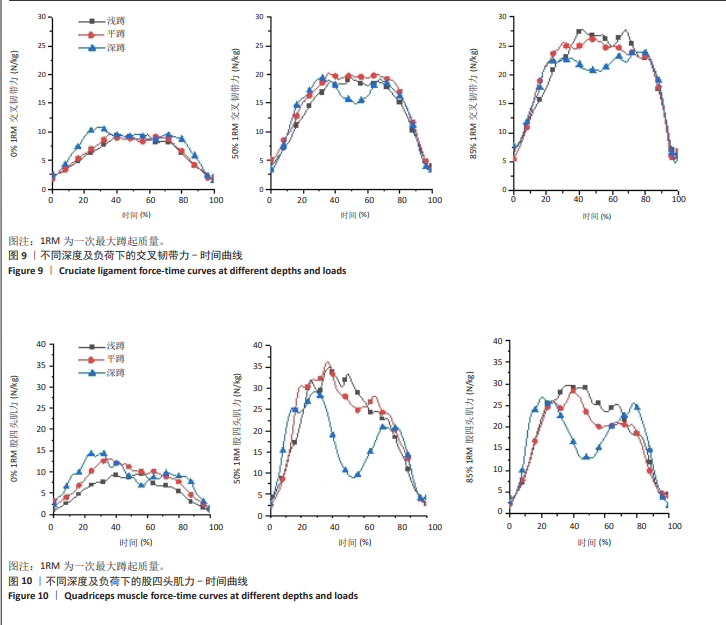
| [1] STASTNY P, KOLINGER D, PISZ A, et al. Effects of Eccentric Speed during Front Squat Conditioning Activity on Post-activation Performance Enhancement of Hip and Thigh Muscles. J Hum Kinet. 2024; 91(Spec Issue):5-18. [2] ILLMEIER G, RECHBERGER JS. The Limitations of Anterior Knee Displacement during Different Barbell Squat Techniques: A Comprehensive Review. J Clin Med. 2023;12(8):2955. [3] WEI W, ZHU J, REN S, et al. Effects of progressive body-weight versus barbell back squat training on strength, hypertrophy and body fat among sedentary young women. Sci Rep. 2023; 13(1):13505. [4] CORATELLA G, TORNATORE G, CACCAVALE F, et al. The Activation of Gluteal, Thigh, and Lower Back Muscles in Different Squat Variations Performed by Competitive Bodybuilders: Implications for Resistance Training. J Int J Environ Res Public Health. 2021; 18(2):772. [5] IACOBESCU GL, IACOBESCU L, POPA MIG, et al. Genomic Determinants of Knee Joint Biomechanics: An Exploration into the Molecular Basis of Locomotor Function, a Narrative Review. Curr Issues Mol Biol. 2024; 46(2):1237-1258. [6] ARIEL BG. Biomechanical analysis of the knee joint during deep knee bends with heavy load. J Biomech IV. 1974:44-52. [7] WRETENBERG P, FENG Y, ARBORELIUS UP. High- and low-bar squatting techniques during weight-training. J Med Sci Sports Exerc. 1996;28(2):218-224. [8] SALEM GJ, POWERS CM. Patellofemoral joint kinetics during squatting in collegiate women athletes. J Clin Biomech (Bristol, Avon). 2001; 16(5):424-430. [9] BRYANTON MA, KENNEDY MD, CAREY JP, et al. Effect of squat depth and barbell load on relative muscular effort in squatting. J Strength Cond Res. 2012;26(10):2820-2828. [10] PETERSON MD, RHEA MR, ALVAR BA. Applications of the dose-response for muscular strength development: a review of meta-analytic efficacy and reliability for designing training prescription. J Strength Cond Res. 2005;19(4):950-958. [11] SMILIOS I, PILIANIDIS T, SOTIROPOULOS K, et al. Short-term effects of selected exercise and load in contrast training on vertical jump performance. J Strength Cond Res. 2005;19(1):135-139. [12] FLANAGAN S, SALEM GJ, WANG MY, et al. Squatting exercises in older adults: kinematic and kinetic comparisons. J Med Sci Sports Exerc. 2003;35(4):635-643. [13] COTTER JA, CHAUDHARI AM, JAMISON ST, et al. Knee joint kinetics in relation to commonly prescribed squat loads and depths. J Strength Cond Res. 2013;27(7):1765-1774. [14] CLARK DR, LAMBERT MI, HUNTER AM. Muscle activation in the loaded free barbell squat: a brief review. J Strength Cond Res. 2012; 26(4):1169-1178. [15] WRETENBERG P, FENG Y, LINDBERG F, et al. Joint moments of force and quadriceps muscle activity during squatting exercise. J Scand J Med Sci Sports. 1993;3(4):244-250. [16] HARTMANN H, WIRTH K, KLUSEMANN M. Analysis of the load on the knee joint and vertebral column with changes in squatting depth and weight load. J Sports Med. 2013;43(10):993-1008. [17] HAFF GG, TRIPLETT NT, eds. Essentials of strength training and conditioning 4th edition. M Human kinetics, 2015. [18] BORG GA. Psychophysical bases of perceived exertion. J Med Sci Sports Exerc. 1982;14(5):377-381. [19] GORDON D, ROBERTSON E. Research Methods in Biomechanics. M USA: Human Kinetics. 2004:64-65. [20] 王琨. 跳远运动员起跳腿专项能力测试及肌肉生物力学特性的研究[D].上海:上海体育学院,2002. [21] ESCAMILLA RF, ZHENG N, MACLEOD TD, et al. Cruciate ligament forces between short-step and long-step forward lunge. J Med Sci Sports Exerc. 2010;42(10):1932-1942. [22] ESCAMILLA RF, FLEISIG GS, ZHENG N, et al. Biomechanics of the knee during closed kinetic chain and open kinetic chain exercises. J Med Sci Sports Exerc. 1998;30(4):556-569. [23] KADABA MP, RAMAKRISHNAN HK, WOOTTEN ME, et al. Repeatability of kinematic, kinetic, and electromyographic data in normal adult gait. J Orthop Res. 1989;7(6):849-860. [24] MIYATANI M, KANEHISA H, ITO M, et al. The accuracy of volume estimates using ultrasound muscle thickness measurements in different muscle groups. Eur J Appl Physiol. 2004;91(2-3):264-272. [25] IKAI M, FUKUNAGA T. Calculation of muscle strength per unit cross-sectional area of human muscle by means of ultrasonic measurement. J Int Z Angew Physiol. 1968;26(1):26-32. [26] WALLACE DA, SALEM GJ, SALINAS R, et al. Patellofemoral joint kinetics while squatting with and without an external load. J Orthop Sports Phys Ther. 2002;32(4):141-148. [27] UZUNER S, LI LP. Alteration in ACL loading after total and partial medial meniscectomy. J BMC Musculoskelet Disord. 2024;25(1):94. [28] LUTZ GE, PALMITIER RA, AN KN, et al. Comparison of tibiofemoral joint forces during open-kinetic-chain and closed-kinetic-chain exercises. J Bone Joint Surg Am. 1993;75(5):732-739. [29] DAHLKVIST NJ, MAYO P, SEEDHOM BB. Forces during squatting and rising from a deep squat. J Eng Med. 1982;11(2):69-76. [30] MURAOKA H, SUZUKI T. Effects of trunk anterior tilt and knee joint flexion angle changes on muscle activity in the lower limb muscles. J Phys Ther Sci. 2021;33(6):472-479. [31] STUART MJ, MEGLAN DA, LUTZ GE, et al. Comparison of intersegmental tibiofemoral joint forces and muscle activity during various closed kinetic chain exercises. J Am J Sports Med. 1996;24(6):792-799. [32] NUSIA J, XU JC, KNÄLMANN J, et al. Injury risk functions for the four primary knee ligaments. J Front Bioeng Biotechnol. 2023;11:1228922. [33] OGAWA M, HASHIMOTO Y, MOCHIZUKI Y, et al. Effects of free weight and body mass-based resistance training on thigh muscle size, strength and intramuscular fat in healthy young and middle-aged individuals. J Exp Physiol. 2023;108(7):975-985. [34] SANTOS LD, AIDAR FJ, SOUZA RLM, et al. Evaluating the Asymmetry of Muscle Activation and Strength in Paralympic Powerlifting Athletes. J Eur J Investig Health Psychol Educ. 2023;13(9):1645-1654. [35] KAWAMA R, TAKAHASHI K, WAKAHARA T. Effect of Hip Joint Position on Electromyographic Activity of the Individual Hamstring Muscles During Stiff-Leg Deadlift. J Strength Cond Res. 2021;35(Suppl 1): S38-S43. [36] VAN DEN TILLAAR R, LARSEN S. Kinematic and EMG Comparison Between Variations of Unilateral Squats Under Different Stabilities. J Sports Med Int Open. 2020;4(2):E59-E66. [37] LARSEN S, DE ZEE M, KRISTIANSEN EL, et al. A Biomechanical Comparison Between a High and Low Barbell Placement on Net Joint Moments, Kinematics, Muscle Forces, and Muscle-Specific Moments in 3 Repetition Maximum Back Squats. J Strength Cond Res. 202438(7):1221-1230. |
| [1] | Zhang Nan, Meng Qinghua, Bao Chunyu. Characteristics and clinical application of ankle joint finite element models [J]. Chinese Journal of Tissue Engineering Research, 2026, 30(9): 2343-2349. |
| [2] | Zheng Wangyang, Fei Ji, Yang Di, Zhao Lang, Wang Lingli, Liu Peng, Li Haiyang. Finite element analysis of the force changes of the supraspinatus tendon and glenohumeral joint during the abduction and flexion of the humerus [J]. Chinese Journal of Tissue Engineering Research, 2026, 30(9): 2199-2207. |
| [3] | Cai Qirui, Dai Xiaowei, Zheng Xiaobin, Jian Sili, Lu Shaoping, Liu Texi, Liu Guoke, Lin Yuanfang. Mechanical effects of Long’s traction orthopedic method on cervical functional units: quantitative analysis of biomechanical model of head and neck [J]. Chinese Journal of Tissue Engineering Research, 2026, 30(9): 2208-2216. |
| [4] | Rao Jingcheng, Li Yuwan, Zheng Hongbing, Xu Zhi, Zhu Aixiang, Shi Ce, Wang Bing, Yang Chun, Kong Xiangru, Zhu Dawei. Biomechanical differences between the new proximal femoral stable intramedullary nail and traditional intramedullary nail#br# [J]. Chinese Journal of Tissue Engineering Research, 2026, 30(9): 2217-2225. |
| [5] | Chen Long, Wang Xiaozhen, Xi Jintao, Lu Qilin. Biomechanical performance of short-segment screw fixation combined with expandable polyetheretherketone vertebral body replacement in osteoporotic vertebrae [J]. Chinese Journal of Tissue Engineering Research, 2026, 30(9): 2226-2235. |
| [6] | Zhou Daobin, Wang Kehao, Xie Yang, Ning Rende. Biomechanical characteristics of volar locking plate only versus combined dorsal mini-plate fixation of distal radius fractures with dorsal ulnar fragment [J]. Chinese Journal of Tissue Engineering Research, 2026, 30(9): 2255-2261. |
| [7] | Zeng Xuan, Weng Rui, Ye Shicheng, Tang Jiadong, Mo Ling, Li Wenchao. Two lumbar rotary manipulation techniques in treating lumbar disc herniation: a finite element analysis of biomechanical differences [J]. Chinese Journal of Tissue Engineering Research, 2026, 30(9): 2153-2161. |
| [8] | Wu Hongxu, Liu Xuanyu, Wang Taoyu, Wang Shiyao, Cheng Jingyi, Zhang Mingwen, Zhang Yinxia, Liu Zhihua, Wang Xiaojie. Finite element simulation of scoliosis with muscle unit introduction: verification of correction effect under bidirectional load [J]. Chinese Journal of Tissue Engineering Research, 2026, 30(9): 2172-2181. |
| [9] | Liu Jiafu, Ren Ruxia, Liao Zhouwei, Zhou Xiali, Wu Yihong, Zhang Shaoqun. Three-dimensional finite element analysis of cervical spine biomechanical characteristics in a rat model of cervical vertigo [J]. Chinese Journal of Tissue Engineering Research, 2026, 30(9): 2182-2190. |
| [10] | Zhang Zizheng, Luo Wang, Liu Changlu. Application value of finite element analysis on unicompartmental knee arthroplasty for medial knee compartmental osteoarthritis [J]. Chinese Journal of Tissue Engineering Research, 2026, 30(9): 2313-2322. |
| [11] | Zhang Xianxu, Ma Zhong, Liu Xin, Huang Lei, Shen Wenxiang, Luo Zhiqiang . Lumbar fusion combined with unilateral fixation for lumbar degenerative diseases: biomechanics, technical evolution, and clinical applications [J]. Chinese Journal of Tissue Engineering Research, 2026, 30(9): 2334-2342. |
| [12] | Wang Baiyan, Yang Shu, Wang Yiming, Wu Mengqing, Xiao Yu, Guo Zixuan, Zhang Boyi, Feng Shuying. Exosome-delivered CRISPR/Cas system enables gene editing in target cells [J]. Chinese Journal of Tissue Engineering Research, 2026, 30(7): 1839-1849. |
| [13] | Zhong Caihong, Xiao Xiaoge, Li Ming, Lin Jianhong, Hong Jing. Biomechanical mechanism of sports-related patellar tendinitis [J]. Chinese Journal of Tissue Engineering Research, 2026, 30(6): 1417-1423. |
| [14] | Zhou Jian, Zhang Tao, Zhou Weili, Zhao Xingcheng, Wang Jun, Shen Jie, Qian Li, Lu Ming. Effects of resistance training on quadriceps mass and knee joint function in patients with osteoporosis and sarcopenia [J]. Chinese Journal of Tissue Engineering Research, 2026, 30(5): 1081-1088. |
| [15] | Yu Xinlin, Chen Huiyu, Wang Yingying, Guo Weizhong, Feng Bin Lin Chengshou, Lin Wang. Finite element analysis of internal fixation with new retrograde intramedullary nail on lateral femur condyle for distal type A2 femur fractures [J]. Chinese Journal of Tissue Engineering Research, 2026, 30(3): 546-552. |
| Viewed | ||||||
|
Full text |
|
|||||
|
Abstract |
|
|||||
